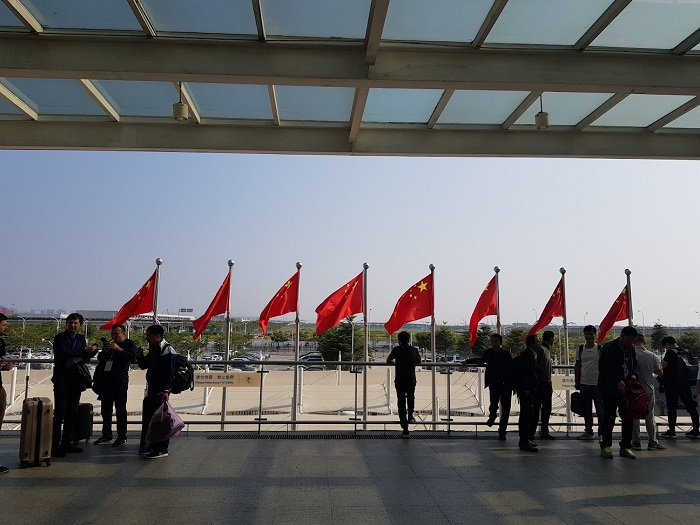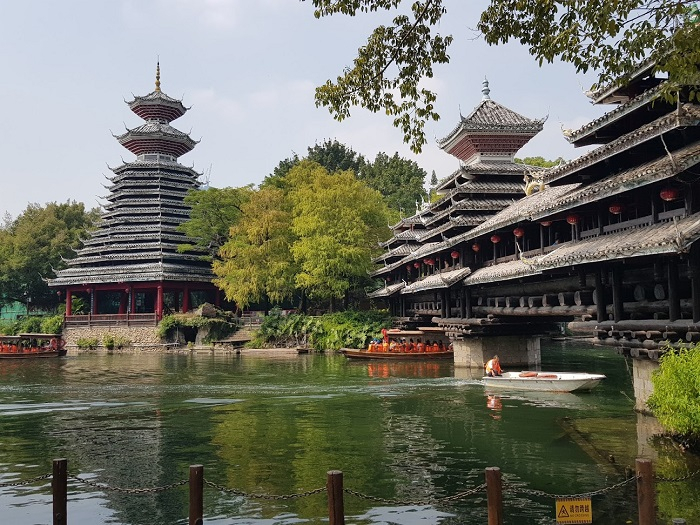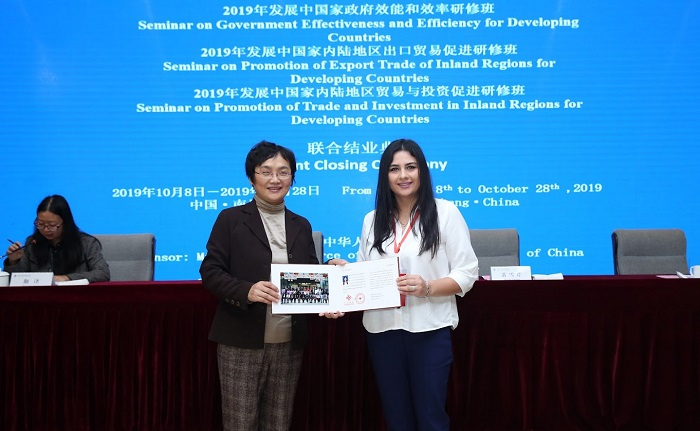In 2019, seminars on Chinese culture, economic-political and international relations, administrative services, public administration system, "Belt and Road" project, development path and other topics were organized for civil servants of developing countries in different provinces of the People's Republic of China. I was sent from my workplace to participate in these seminars.
We left for China in early October 2019 with a four-member delegation to attend a 21-day workshop on “Government Effectiveness and Efficiency for Developing Countries” organized by the Ministry of Commerce of the People's Republic of China (MOFCOM) and Jiangxi College of Foreign Studies. The seminar would be attended by 42 delegates from 12 countries besides Azerbaijan.

After waiting for 8 hours in Moscow for a transit flight, we flew a seven-hour flight on October 7 and arrived in Guangzhou, the capital of China's Guangdong Province. The first thing I remember was the rudeness of the airport staff here. As in other countries I have travelled to, what I saw here was new to me. Although it was October, Guangzhou was very hot. I even had my favourite monsoon rain.
The human spirit was at rest as he watched the cleanliness, the variety, and the beauty of nature on the streets. Located in Guangzhou, the Canton Tower, the second tallest in the world, is more than 600 meters long. We travelled a long way from the airport to the city center by subway to see this tower. In this area on the banks of the Pearl River, many new buildings, a large library with an area of 98,000 square meters and a ten-storey Guangzhou Library also attracted our attention.
After spending 7-8 hours in Guangzhou, we flew to Nanchang on a domestic flight. At the airport, we and participants from other countries were greeted by the staff of the College where we were stationed, Hu Yan (Carolina) and Amber (Liu Xiaowei). It is 02:00 at night. We had not slept for more than 24 hours, and we were too tired to move. Before staying at the hotel, we were given a 21-day program in the lobby and books in bags, stationery for lessons and an umbrella as the weather was rainy.
A college that studies the world
Our first acquaintance lesson started at 9 o'clock in the morning in the conference hall of the hotel. Before giving information about the classes, I would like to share information about the Jiangxi College of Foreign Studies. It is a college established jointly by the People's Government of Jiangxi Province and the Ministry of Commerce of China and provides a training base for leading government officials. The college consists of 12 departments and 49 specialities, including 11 foreign languages.
In addition, the college has rooms equipped for training, education, meetings and entertainment. There are also conditions for students to live here. Since 2010, the College has been majoring in public administration, energy and minerals, trade and economics, manufacturing, transport and logistics, finance, party and government, business services, water conservation and environmental management, culture and sports. is the organizer of aid training projects. These projects include training courses and seminars.
The College organized more than 300 seminars and training projects in 2018-2019 alone, training more than 6,000 civil servants from 126 developing countries, including Asia, Europe, Africa and South America. One person attends the workshop, which costs the Chinese government at least $ 25,000 to $ 30,000, but the Chinese Ministry of Commerce still attracts thousands of government officials from around the world to demonstrate the country's development to other countries and gain experience.
In the first lesson, the partners of the College Caroline, Vicky (Huang Shan) and Amber taught us how to write, sing, count, and speak words in Chinese. In a short time, they became our best friends. These 3 Chinese ladies solve each of our problems immediately and help us in everything. In addition to their own names, the Chinese also have short English names, so we addressed these Chinese women with short names. On the second day of the seminar, the opening ceremony was held at the College. The leadership of the college and the ministry greeted the seminar participants and gave a reception in our honour.
According to our 21-day program, from 9 am to 5 pm, professors and researchers from various scientific institutions taught us about China's development strategy, the role of non-governmental organizations in governance, preservation of national values in local government and governance, public services, economic reforms, management of economic activity, evaluation of state activity, budget reforms, civil service, demographic situation of the population, “Belt and Road” project, agriculture, application and efficiency of e-government, Chinese culture, etc. seminars on important topics were held.
After the seminar, some days we walked with the organizers, and sometimes we visited the sights of the city ourselves. On weekends, we travelled to other cities. We had a wonderful time with other delegates after the seminar, giving information about our country, listening to their music, some of them said they missed their families, in short, everyone had a word to say.
Nanchang, where the streets are washed with water steam
Nanchang is the capital of Jiangxi Province. This developing city has a population of over 6 million. The streets were washed and disinfected day and night, and the dusty air of the city was cleaned by water vapour with specially equipped machines. It is impossible to visit the big shopping centers of this city in one day. All the streets are full of small shops selling street food, national souvenirs and ornaments, tea shops, seafood markets. While we were there, it coincided with the 70th anniversary of the founding of the People's Republic of China. The city was completely decorated with flowers and national ornaments. The most popular tourist attractions in Nanchang are the Pavilion of Prince Teng, built-in 653, the Shengjin Tower built-in 904-907, the Musical Fountain Square, Bayi Square and the second largest in the world is the 160-meter-high "Nanchang Star", which is considered the tallest devil's wheel. The Riantea Gallery on the outskirts of the city was my favourite place. This tea factory, located in the bosom of nature, produces expensive Chinese teas and sells them abroad. When I tasted the tea, I realized that what we drank was colored water, and that was the real taste of tea.

The people of these places have a lot of respect for the guests and tourists they see in the city, and even if they do not know a foreign language, they try to help in any matter. In general, many nuances show that the Chinese are very cultured, polite, hospitable and restrained. Considering that not everyone ate Chinese cuisine, they set the guests' table separately from their own, and even in the hotel where we stayed, food was prepared for us separately. Let me also note that the food was not artificial food that we saw on the Internet. The food was natural and delicious. At least the broiler chickens weren't as spoiled as ours. While we were there, almost everyone used a medical mask indoors and on public transport. However, the pandemic had not yet begun. The organizers paid us an additional $ 10 per day, which we almost did not need. Because every payment we received, except for personal items, was welcomed by the inviting party.
Homeland of porcelain
Our first-weekend trip was to Wuyuan county. Consisting of 1 subdistrict, 10 towns and 6 townships this ancient district is considered a national-cultural, ecological tourism region and is called "Green Pearl" because of its beautiful nature. It is also known as the most beautiful village in China. After a day of sightseeing, we headed to Jingdezhen. With a history of 2,000 years, the city has been producing Chinese ceramics for more than a thousand years and is known as the "Porcelain Capital". The availability of porcelain stone reserves in Jiangxi Province has led to its widespread use. Jingdezhen porcelain is the most important and high-quality ceramic tile in China. It should be noted that the Chinese also invented a combination of high-temperature colors for painting dishes. Potters are so talented that they can make anything from porcelain. In many streets and parks, light poles, seats, roadside, flower pots, tables and chairs in cafes, etc. Everything that comes to mind is made of white-blue porcelain decorated with Chinese national ornaments. We came to the "China top porcelain exhibition hall" to listen to information about the city. The dishes lined up at this exhibition are made to order and are presented to heads of state and officials as expensive gifts. Then we went to the “Jingdezhen Ancient Kiln and Folk Customs” museum, located in the bamboo forest, where porcelain dishes are made. The statues at the entrance to the museum, called the Chinese Zodiac, are reminiscent of Jackie Chan's film of the same name. The largest wood-fired ceramic stove in the Guinness World Records in 2009 is also located here. Local and foreign experts and potters call this museum the "Museum of Living Ceramics". Potters of all ages, together with their old masters, cope with this task very professionally, and the potters say that this art is inherited from their genes. These handicrafts are so beautiful and elegant that it was very difficult to decide which one to buy, everyone consulted with each other, everyone tried to get the most beautiful. We transported the dishes and decorations we bought to Baku very carefully. In the ceramic folk culture area of the museum, ceramic dances and music performed by musicians in national costumes with ceramic musical instruments are demonstrated for tourists. Their costumes, dances and performances in harmony with nature and ceramics have a very pleasant effect on people.
We talked about ourselves
After returning from a 3-day trip, we continued our interesting seminars. We continued to learn interesting information about public administration in China from well-known teachers who trained us. One of our lessons was "Introduce your country". We prepared a presentation in a few hours with our very friendly, professional and knowledgeable group of 4 people. Along with other participants Farid, Muzaffar and Hasanaga, our 20-minute presentation provided general information about the country, including our independence, culture, Karabakh war, political and economic relations, history of Azerbaijan, economic development, current government, international competitions and contests, the Azerbaijani brand “ASAN service” and favourable business and investment environment, we proudly presented our achievements in various fields to the participants of the seminar and presented a short introductory film about Baku. Our presentation was applauded.

Expensive Shanghai and "fake market"
On the second weekend, our 42-member delegation and 6-7-member organizing group travelled by high-speed train to Shanghai, China's largest city. In China, trains are classified by different letters according to their speed. The newest and highest speed trains are G-type trains with a speed of 250+ per hour and a maximum speed of 380 km / h. For example, the 1,385-kilometer road from Beijing to Shanghai takes 4 hours and 17 minutes. Tickets for these trains are also expensive. Tickets for 334 Chinese yuan (about 90 AZN) were presented to us at Nanchang Railway Station. The distance between Nanchang and Shanghai by train is 741 km. Train G took us this distance in 3 hours. We were moving at a speed of 280/300 km per hour.
We got off the train at Shanghai's Hongqiao Railway Station. At this invisible station, our guide accompanied us with a fish-shaped flag. In order not to get lost, we followed the colour of the flag to the tourist buses. The streets of Shanghai are very crowded, and when you look at the labyrinthine streets, you can imagine Chinese movies.
Located in the Yangtze River Delta, Shanghai has a population of 25 million and is the world's most lucrative tourist city. It was considered the most important port city in China after the opening of the commercial port and became the first metropolis in the Far East. Shanghai is considered a mirror of China's developed economy. Built-in Pudong, the city's central district, the Lujiazui skyline is the most beautiful view of the city, reflecting several architectural styles. This is a peninsula formed by a bend in the Huangpu River flowing through the city.
China's first and the world's second tallest building, the 632-meter-long 128-storey Shanghai Tower, the 492-meter-long 101-storey Shanghai World Financial Center, the world's fifth-tallest 468-meter-long East Pearl TV Tower, along with the 421-meter-high, 88-story Jin Mao Tower (Shanghai's business card), which means "Golden Prosperity Building” other skyscrapers have been built along the line.
We came to the Shanghai Tower to see these places up close. After visiting the general layout of the city in the first hall, information boards about the buildings, the mysterious exhibition of extraordinary beauties, we climbed to the 118th floor in 55 seconds with the world's highest speed elevator moving at 18 meters per second. Here you can watch Shanghai in a 360-degree view. Living adrenaline on the glass floors, it was great to see this metropolis in the palm of your hand. After touring the city by bus, we returned to the hotel in the evening.
The happiness of Turkish cuisine
We were in China for fifteen days, and no matter how rich and delicious our food was, we were already longing for Azerbaijani tea and food. I think this is the main problem of every Azerbaijani living abroad or going for a walk. When we found the Turkish restaurant “Efes Turkish & Mediterranean Cuisine” on the map, our joy knew no bounds. We were happy to choose dishes from the menu that we would not eat in Baku for a long time so that we would finally feel like a native. Turkish tea was our ointment. The food we pay 15 manats in Baku cost 60 manats here, however, we were very happy to find our taste. Then we went to Nanjing Road, the main shopping street in Shanghai. This street, where elite boutiques, shops and restaurants are located, is also home to the People's Square, the Shanghai Theater, a museum and other interesting places.
We also visited the pearl and gold shops of this city, which is famous for its pearls. None of us bought these items at fantastic prices. Guides took us to “A.P. Plaza Yinyang Market” where all brands were counterfeited. Shopping and fraud in this market are so intense that they end up begging for $ 10,000 and selling it for $ 10. For example, 14 people bought a small suitcase of the same brand. But we each paid a sum for the suitcase, some very expensive, some very cheap. In the evening we came to see “ERA Acrobatic Show”. How talented the Chinese were, they performed incredible shows. Probably only the Chinese are able to perform such dangerous actions with such precision and perfection.

So, after two days of walking in this city full of wonders, we flew from Pudong Airport to Shenzhen. Our Spanish-speaking friends from Venezuela and Panama sang along the way and entertained us with Spanish songs. Although I thought I would not be surprised in any city after Shanghai, Shenzhen still amazed us with its greenery, nature, cleanliness and innovations. Shenzhen, a special economic zone with a population of 17 million, is the main city of Guangdong Province. The port of Shenzhen is the world's fourth busiest container port, serving as a gateway to attract investment, new technology and business culture. Excursions to many administrative buildings and public service centers were organized for us. For the first time, I saw tank-like service vehicles for police and soldiers on duty, Segway-type transportation systems, and blue electric taxis. As I realized that you can not amaze a Chinese with any updates.
An amusement park called Splendid China Folk Village was also one of our attractions. Covering an area of 30 hectares, this magnificent park consists of two parts: a miniature park and a village of folk culture. The park reflects the history, culture, art, ancient architecture, customs and traditions of the Chinese nation. More than 100 Chinese tourist attractions in the park have been miniatured according to a map of China. There are paid cars and trains to transport visitors around the park, including the Great Wall of China, the Forbidden City, the Temple of Heaven, the Summer Palace and more allows you to visit miniature models in one day. There are also shows reflecting various events in Chinese history, war history and culture.
Our friendship continues
After our visit, we returned to Nanchang. After attending the workshops for another 3 days, we prepared a short presentation on the topics we learned. After the presentation, each country had to submit an independent report on the workshop. At the closing ceremony of the seminar, we were presented with certificates and souvenirs. The participants returned to their countries in parts within two days. For three weeks, we parted company with friends, both laughing and giggling. Carolina, Amber, Vicky, and Zong Pinghua, the director of the college, did not leave us alone for a day. We left China with very good memories.
3 years have passed. Although seminars have been suspended due to the global pandemic, the College sends us congratulatory letters every holiday.

Jiangxi College of Foreign Studies sent a letter to those who wished to participate in the seminars again, writing an article on "My story with China" and inviting them to share our memories. So, 3 years later, I wrote down my impressions of this trip, which I have not forgotten.

Laman Aghayeva is a lawyer.
More about:
















































